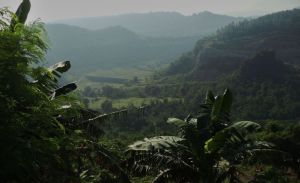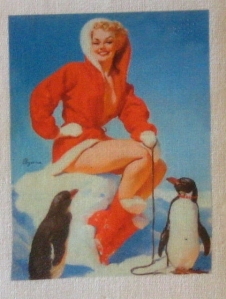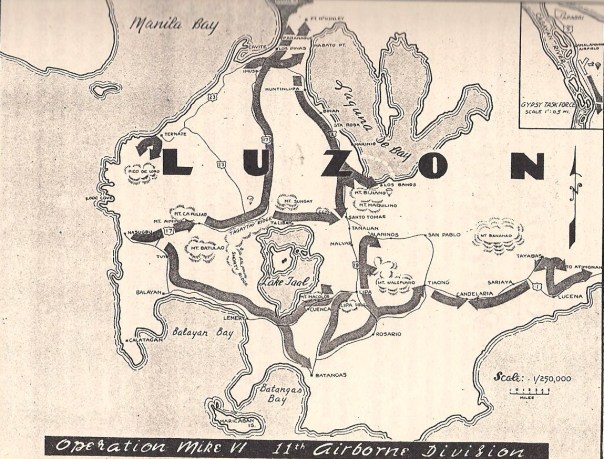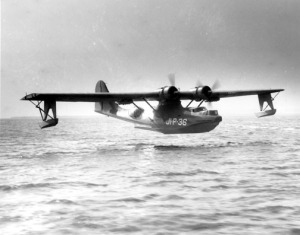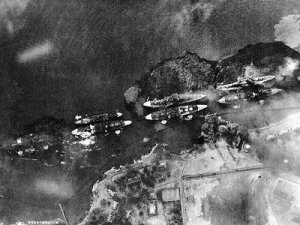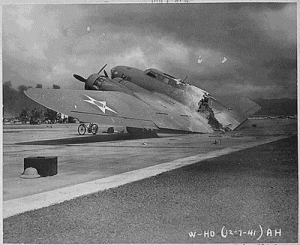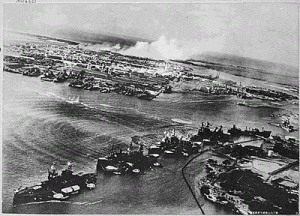Monthly Archives: December 2012
Keep moving men …
MacArthur had given orders to Gen. Eichelberger to push the 11 Airborne Division as hard and fast as possible. The unit’s commander, General Swing, was eager to please; if fact – he was way ahead of the brass. (as usual) and the men were only too happy to make “Uncle Joe” (or “Jumpin’ Joe) proud of them.
The 11th numbered 8,200 men, about half that of a normal division. The 187th and 188th regiments had no heavy weapons, cannon or antitank companies; the 511th had only three rifle companies. The artillery was made up of two 75mm pack howitzer battalions and a 105-mm howitzer battalion with a short barrel howitzer. The 221st medical was attached to the 187th.
The Genko Line, manned with 6,000 Japanese soldiers, had roads mined with 500 pound aerial bombs and low pressure detonators. The 1,200 pillboxes that stretched from the high ground of Fort McKinley through the Manila Polo Club and across Nichols Field to the high ground of Mabato Point along Laguna de Bay were stocked with 20mm and 6 inch guns from Japanese warships. The extensive preparation for this defense began in 1942 when the Japanese first conquered the island. In the mountain areas, the tunnels wound around and opened up into supply rooms, living quarters, shrines, hospitals, etc. It was virtually an underground city and military headquarters.
At dawn, part of the 187th was at the base of Mount Aiming. This is a 1,200 foot, densely wooded mountain at the start of Mount Cariliao and then Mount Batulao. The three mountains made up a natural defense for the enemy as they truthfully peered down on the Americans. Machine gun fire, mortars, heavy artillery and grenades bombarded the men to greet the morning of February 1, 1945.
The men of the 11th were, according to the G-2 intelligence, up against some of the best enemy combat troops and they were capable of watching the soldiers advance uphill. The 674th and 675th Glider Artillery Battalions moved into position to assist the 1887th and 188th as they began their assault at 0900 hours. The area became strafed by the Air Corps fighter and A-20s. The men used rifles, bayonets and grenades to fight their way to the peak; often using the enemy caves for their own protection. By 1600 hours, they had achieved their goal. By reaching the top of Mount Aiming, the Americans had split the Japanese defense line in half.
_____________________________________________________________________________________________________________________
My thanks go to General Flanagan for the exact hourly timeline of this brutal day. Anyone interested in WWII should check into all of his books.
_____________________________________________________________________________________________________________________
https://www.dropbox.com/sh/f10cagxjwrhehjp/AAASEMNcyLfhlnxwAMizxvDja?dl=0
Personal note – Judy, from greatestgenerationlessons.wordpress.com, has invited me back to her site for another guest post. My article on the state of affairs for the American family during the WWII era will appear on Monday, January 7, 2013.
Judy and I would greatly appreciate to hear your additions or feelings on the subject.
X-Day
I have to maintain on January 31, 1945, as this is where the actions of Smitty and the 11th Airborne Division become quite confusing. While the 221st medical is attached to the 187th, the 187th itself is split and send in alternate directions. Up until now, the division has been maintained fairly well in secret from the Japanese, but it is here that Gen. Eichelberger not only wants to allow the enemy knowledge of their existence, he wants to (in his words) pull a “monumental bluff” and splash the landing across the newspapers.
The men hit the beach with only their necessities on their backs; their personal items would not be seen for two months. The Eichelberger/Swing strategy began at dawn with the convoy’s arrival at the shore. 0700 hours – eighteen A-20’s and nine P-38s strafed the beaches.
0715 hours – the navy began to shell the landing area with rockets from the LCIs and shells from the destroyers.
0815 – cease fire, beach party lands
0822 – no opposition from enemy reported; first wave of 8 LCVPs lands, men head toward Nasugbu only 1500 yards away.
0945 – the 188th was through Wawa, Nasugbu and the airstrip.
1030 – the 187th begins landing and immediately joined up with the others to head up to Tagatay Ridge. One unit of the 187th remains to defend Nasugbu, one battery of the 674th assists. The 102d AAA AW Battalion and the 152d AA-AT Battalion set up antiaircraft defense on the beach.
1300 – the beach was clear – Eichelberger and Swing head down Highway 17
1400 – Gen. Swing notified Admiral Fechteler that all the men were ashore and he would resume command. Little did the 11th know that for a few brief hours, they were under the command of a naval admiral!
1430 – all key elements were 8 miles from the beach and at the Palico Bridge. It was saved just as a squad of Japanese were about to blow the steel and wood structure.
1600 – the 188th set up a CP in the Palico barracks.
All companies continued to moved forward. Artillery, rifle and machine gun fire erupted shortly afterward.
The monumental bluff was created by: a flying boatload of correspondents that blasted the news that the “Eighth Army had landed on Luzon,” and Eichelberger ordered Swing to have the 187th and 188th move as quickly as possible, fire as much artillery and weapons and create as much dust as possible. All vehicles raced down the dirt roads, guns blazing and air strikes thrown in made the division appear to not only be of immense size, but that they also had an armored unit with them.
They would now be coming up on the infamous Genko Line; a stretch of blockhouses and pillboxes that contained guns from Japanese warships, 20mm, 6 inch, etc. The enemy had dug massive octopus traps called takotsubo. All this needed to be destroyed before liberation of Manila and elimination of the 20,000 soldiers waiting for them within the city limits. For this action, the 11th would be granted the Presidential Unit Citation.
The 187th went down the steep southern slope of Tagatay and progressed to the north shore of Lake Taal where they were ordered to take Tanauan. The 127th Engineers carved out a road on the vertical cliffs for them.
______________________________________________________________________________________________________________________
For more current WWII news – According to The Week magazine: A World War II veteran was able to hear a symphony he wrote 67 years ago, for the first time, when the U.S. Army Orchestra premiered it in Washington D.C. Retired Colonel Harold Van Heuvelen, 93, was inspired by his experiences as a soldier to write the symphony in 1945. When his son found the music, he launched a campaign to have the Army play it. The composition drew rapturous applause and a standing ovation for the composer.
Also – When Joshua Neldorf celebrated his bar mitzvah in Sept. he decided to donate $13,000 (most of his gifts) to Operation Mend which provides medical services to American soldiers with facial injuries. His generosity was inspired by a family friend, Sgt. Louis Dahlman who was injured by a roadside bomb in Iraq in 2007.
Locally – south of me, submerged in 240 feet of water, a World War II Navy F6F Hellcat was located off of Miami Beach. Florida was used for training Navy and Marine pilots during that war. Since the nearly intact wreckage is embedded in the sand and upside-down, it is not known if the pilot is buried with his plane.
Christmas in 1940’s style
 A very Merry Christmas to all in WWII era style. My best wishes and thanks to those of you who happen to pass this way.
A very Merry Christmas to all in WWII era style. My best wishes and thanks to those of you who happen to pass this way.
To the Military: My prayers and thanks go to you for your service and we all hope to see you soon.
To those who do not celebrate this holiday: I wish you the good blessing and heartfelt emotions that are symbolized in the season.
Race for Manila begins
By the beginning of February, 1945, the US Navy reported: since 19 June 1944, the Japanese have been losing 50 shipping vessels per week. The US B-29’s, after bombing Singapore harbour, demolished the enemy shipping vessels there. The US Air Force had begun to bomb Japan’s homeland as well. Japan felt that if they beef-up their forces in the Philippines and were to drive the Allies off the islands, the United States would be forced to ease up on their bombardments. Enemy replacements and war materiel began to pour onto Luzon.
3 February, 1945 is considered the starting date for the battle for Manila. The Japanese are actually trapped in the city between the 11th Airborne Division moving up from the south and XIV Corps from the north. This battle will go on all through the month with some of the most ferocious fighting of the war.
While advancing, the 11th A/B encountered heavy barrages from machine guns, mortars, artillery and grenades streaming from tunnels and caves above the highway. After the enemy was eradicated, the command post dug in on the side of the road. In the middle of the night, they were attacked. Headquarters Company used flame throwers and rifle fire to fend them off.
My father would wrinkle his nose at the mere sight of a flame thrower on tv. He said, “Once you smell burning flesh, it stays with you. There’s nothing worse. Everytime I see one of those things flare up, even in a movie, I can smell the fuel and flesh all over again.
The 11th A/B continued on to Tagatay Ridge where they would come upon more of the enemy. Colonel Soule directed the artillery of the 674th and the 675th while the final assault was made by the infantry. The troopers went uphill through the Mount Cariliao-Mount Batulao defile. This was Shorty Ridge; the eastern area that needed to be free of Japanese before the 511th made their jump. (The regiment had to be capable of meeting up with the rest of the division within twenty-four hours of their landing.) The forward Command Group of the Headquarters Company went through a mile of enemy territory to destroy the resistance on the ridge and make that first contact.
A mere two hours later, the Command Group followed along the fire-swept road and set up the division command post on the ridge. The Reconnaissance Group, right behind them, did not rest, but continued on toward Manila. The Command Group then folded in behind and set up another command post while under heavy fire. It was here that the plans for attacking Manila and Nichols Field were developed.
General Swing now had a supply trail stretching 70 miles and he began to fine tune the missions of some of the units. Colonel Hildebrand and the 187th were sent to Nasugubu and patrol the main supply route. Hildebrand was also put charge of thousands of guerrilla fighters, not an easy job in itself. All in all, him and his regiment had been given a very large task. They were staring into the jaws of the noted Genko Line. (which will be explained soon.)
4-11 February 1945, US President Roosevelt, British Prime Minister Churchill and Russia’s Joseph Stalin met at Yalta in the Crimea for a conference. It was decided that when Germany is defeated, Russia will declare war on Japan. It was clear to all that Stalin was already putting in a claim for territory (the spoils of war) after the Allied victory.
(Click photos to enlarge )
January 1945
Early in January, Japan’s General Yamashita pulled his Fourteenth Army (260,000 men) back off of Luzon’s beach to conserve them. He was aware of the forthcoming invasions of American troops.
27 January, the 11th airborne set sail for the island aboard the transport ships under the command of Admiral Fechteler. The LCIs were crowded and the men ate “10-1” rations (50 pounds of food, enough for ten men) during the cruise. The 188th landed at Lucena and secured the beachhead. Immediately following, the 187th Glider Regimental Combat Team landed to protect the south flank by making certain the enemy could make no approach from the Balayan Bay-Santiago Peninsula area and the 511th would jump on Tagatay Ridge. This was labeled Operation Mike VI; devised by generals Eichelberger and Swing and would be considered quite unusual by most traditional military planners.
All the troopers had been so well briefed on the terrain from aerial photographs and mock-up reliefs that upon their landing the area gave a feeling of deja vu. Once they were on land, they started down Highway 17 toward Tagatay. That journey would consist of approximately 30 miles of valleys, flat terrain of rice and cane fields, mountains and careful traversing along crests of ridges. The distance between Tagatay and Manila was about 37 miles, traveling passed Nichols Field before reaching Manila proper. (the main supply area for the Japanese troops) Manila was a crucial stop-off for the enemy on Guadalcanal, New Guinea and the Solomon Islands.
27-31 January, General Eichelberger wrote to his wife of the beauty in watching the large naval convoy and how much he marveled at their expertise. He also commented, “General Swing is a grand to deal with …” (Frankly, I do not know of one person to ever say something contrary about Swing). He also noted the navy’s ability to keep their sense of humor, that while aboard ship before the landing, he heard over the speaker system. “Sick call — all sick, lame and lazy report to the sick bay.”
31 January was known as X-Ray Day for those bombing Japan. In Luzon, the Japanese forces were basically divided into three groups. The Shobu Group, under the command of General Yamashita, totaled 152,000 men and in control of the northern part of the island. The Kembu Group under Major General Tsukada had 30,000 men and dominated the Clark’s field and Bataan peninsula area. The Shimbu Group was 80,000 strong and ruled over the southern half of the island under Lt. General Yokoyama. The Fuji Forces, named for Colonel Matsatoshi Fujishige, would be created later on. They numbered 8,500 men, but they were working with 5,000 troops of the Surface Raiding Base Force, a unit that consisted of 100 suicide boats, called Maru-ni and operated by another 100 men.
The US Sixth Army, under General Krueger, had landed on Luzon north of Manila before the 11th airborne division went ashore to the south. MacArthur became upset with the slow progress the 6th was making to retake control of the capital and told Gen. Eichelberger, “speed up your ‘palsey-walsey,’ Krueger doesn’t even radiate courage.” Ergo – a rivalry was born and a race between the Sixth and Eight Armies was underway.
The problem was, the 11th airborne had been given more than one priority to handle.
Aerial support
December 12, 2012 would have been Everett Smith’s 98th birthday. I will simply give a salute and say, Thank you for everything, dad. You don’t know how much I miss you. (unfortunately my blog was having technical difficulties Wednesday)
____________________________________________________________________________________________________________________
The B-17 Flying Fortress was a primary resource for both the U.S. Army Air Corps and the Royal Air Force early on in the was. Depite going through fourteen different variations, General Arnold decided that the plane was not the most efficient for the unusual aspects of the Pacific War and it generally maintained a status of completing aerial supply drops.
_____________________________________________________________________________________________________________________
The U.S. B-24 Liberators was capable of of carrying up to 3629kg (8000lb) of bombs and had a range of traveling over 3200km (2000 miles). It was more modern than the B-17 with a longer range, heavier pay load and more speed. This plane was used by almost every army in almost all theaters of operation.
_________________________________________________________________________________________________________________________
B-25 bomber was a medium bomber which was easily controlled. Named after General Billy Mitchell, the only complaint about the plane was how loud it was. The usual joke heard, “The B-25 is the fastest way to turn aviation fuel into noise.” This plane saw service for four decades, with the Army, Air Force and Marines all having their own variations. This was widely used in the Pacific because it was capable of treetop level strafing and parafrag (parachute-retarded fragmentation bombs).
_________________________________________________________________________________________________________________________
The Boeing B-29 has become the most famous bomber since it was the Enola Gay that carried and dropped the first atomic bomb. It was designed to be a Hemisphere Defense Weapon with an extremely long range of 4100 miles and had a bomb load capacity of 20,000 pounds. It was well advanced in that the gun turrets were controlled remotely by the gunners sitting inside and using periscopes to aim their weapons. The plane had a total of ten 12.5mm machine guns.
A common complaint was the Wright R-3350 Duplex Cyclone engine and it was eventually replaced with the Pratt Whitney R-4360.
_______________________________________________________________________________________________________________________
There were numerous other bombers, such as: the Marauder, Dominator, Liberator, B-34, etc., many of which went through different variations.
But, since we are giving credit where credit is due – there were also numerous other planes involved in assisting the ground forces. You had the fighters, such as the P-40 which became known as the plane of the “Flying Tigers.” On February 1, 1945, the Corsair made their first regular operational flight from the US Navy aircraft carriers. It had a kill ratio of 11:1 with it’s six machine guns and capability of soaring 417 mph. The Corsair would become the best of the carrier planes.
And the, you had Dive Bombers, Torpedo bombers, attack planes, Reconnaissance, Cargo and Transport (like the C-46 Commando and C-47 Skytrain), Liason planes, Observation, Seaplanes, and Flying boats – eg. the PBY Catalina, some of which are still in use today. This ship was useful both as a rescue and a bomber.
This post is to give the reader an idea of the constant activity going on in any one area. The Allied forces and each branch worked separately, but simultaneously to accomplish one goal. Perhaps that is one reason why I find the WWII era so interesting. If anyone out there would like to further research this topic, I recommend daveswarbirds.com/usplanes/american.htm as an excellent starting point.
Getting ready for Luzon
21 January 1945, General Swing announced to his force that he was ordering a division review. The 11th Airborne Division was being transferred to the command of the Eight Army and the reviewing officer was would be none other than General Eichelberger, the top commander, himself. Field Order Number 17 informed Swing that the 11th A/B must pack up and move on to the island of Luzon, P.I. Upon arrival they would be expected to retake Manila, destroy the Japanese Genko Line of defense and release all internees being held captive at the prisons, especially Los Banos.
Luzon was the most populated, the most highly developed and the most historical island in the archipelago. It was also a land of wild boars, birds, snakes, reptiles, feral dogs, tons of insects and an enemy hiding within the cogon grass at every turn; the plant had coarse spikes with “silky” hairs that made your skin feel as though hundreds of creatures crawled beneath it. There was always a threat of dengue fever; contracted from a mosquito and if left untreated resulted in bleeding and death. It was here that Smitty contracted a mild case of malaria, but quinine and stubbornness kept him out of the hospital. (He always said that he was one of the lucky ones, but I witnessed one relapse and can not imagine what the unlucky ones had gone through.)
___________________________________________________________________________________________________________________
War or no war – Hollywood would continue to be Hollywood. Gloria Vanderbilt had separated from her husband of two years, Pat deCicco, two months before she was to inherit $4.5 million. Ida Lupino filed for divoece from her husband, Louis Haywood. Obviously, the rich and famous were having a rough time of it during the war.
Then, you have the opposite spectrum. One of many, many examples being – Rod Serling, best known for his televisions shows, “Twilight Zone” and “Night Gallery,” was a Pvt. in the 11th A/B and would earn a Bronze Star.
____________________________________________________________________________________________________________________
24 January, General Swing issued Field Order Number 10 that specifically outlined their orders. To accomplish their task, 120 ships and landing craft would be used to transport the troops, equipment, ammo and replacements for the division up northward approximately 400 miles. They were now numbered 8,200 men, about six thousand short of a normal division.
____________________________________________________________________________________________________________________
Personal note – As people remember Pearl Harbor and honor those that gave their lives, please bear in mind that December 10 thru 13, the Japanese 16th Division went ashore at Lamon Bay, Luzon, P.I., stormed across the island to Tiaong and then headed for the capital, Manila. The Japanese took total air superiority almost immediately. The American and Filipino troops became encircled and the end result would be the Bataan Death March. I will have further information as I bring the U.S. troops into Luzon.
The World in 1940 by gpcox
Judy Hardy was kind enough to invite me to guest write on her blog. This is what appeared on her site yesterday. I have re-blogged the item for your comments and opinions. For one – should we continue the guest writing or no? Thank you for taking the time to stop by.
"Greatest Generation" Life Lessons
On November 16th, I received an email from WordPress.com telling me that gpcox had liked several of my posts and suggested that I check out their Blog, pacificparatrooper.wordpress.com, which I did. I read about the 11th Airborne Division in the war in the Pacific. I also enjoyed reading, with humor, a letter from Smitty to his Mom describing a recipe for “Jungle Juice”. The similarities between our posts was not lost on me and I sent a comment to gpcox. Since we had both started Blogging in September of this year, I thought we might be able to connect and give each other encouragement and advice.
As we emailed back and forth I learned that there were more similarities than I had imagined. Our fathers were born in the same year and drafted within months of each other. There were also sharp contrasts between our Blogs. Mine…
View original post 900 more words
Pearl Harbor Day
I take this interruption in my story to honor those who both served and died in Pearl Harbor, Hawaii.
__________________________________________________________________________________
###############################################################################
Last sight of Leyte
My father swore that this incident occurred, but on which island, I can not say. Although Smitty already felt great respect for his commander, General Swing, he developed even more after witnessing this event: “A bunch of us were hunkered down due to the resistance we suddenly encountered. Everyone dove for cover and tried to figure out where the bullets were coming from except one guy still standing and looking around. (The general did not have his insignia on his uniform.) One G.I. yelled out, ‘Get down you f–kin’ jerk! You want your head blown off?’ I looked over and saw it was the old man himself and thought jeez is that soldier ever going to get reamed when we get back. But, the general got down and nothing was ever said about it.”
There are other stories about Swing that are quite similar, including one where, rather than getting down, he actually walked over to the palm tree where the sniper was firing from and pointed him out as the U.S. sharpshooters dropped him.
_________________________________________________________________________________________________________
From the moment the 11th Airborne landed on Leyte, the fighting was heavy, but they made excellent process across the island. Suzuki’s Thirty-Fifth Army became desperate, especially after the fall of Ormoc, which cut off his troops from their naval supply.
_________________________________________________________________________________________________________
While on Leyte, the 11th A/B was attached to General Krueger’s Sixth Army. A superior reference guide to the movements of this unit can be found in the various books by, Lt. General E.M. Flanagan, Jr. (Ret.). The Angels: A History of the 11th Airborne Division gives detailed accounts by the author, who himself was the commander of the 11th Division’s B Battery of the 457th Parachute Field Artillery Battalion. And – a very nice man I might add. I was privileged to have two phone conversations with the general.
___________________________________________________________________________________________________________
Personal note – I hope many of you will go the greatestestgenerationslessons.wordpress.com on Saturday when I will be a guest writer. We are attempting to put our two stories into perspective as our fathers grow and enter the army during WWII. We request a comment to establish if we have accomplished that goal. Thank you and feel free to comment on this blog as well.


